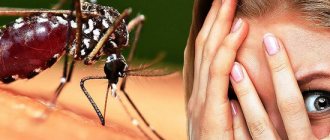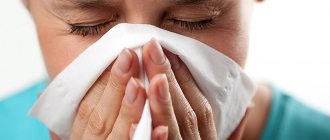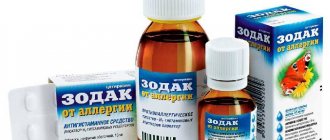Allergy to insect bites in childhood is one of the most common allergic reactions. The degree of its manifestation varies widely - from mild local manifestations affecting only the bite site, to severe hypersensitivity reactions such as anaphylactic shock. More often, severe reactions occur when a child is stung by a bee or wasp. However, allergies in children can occur from the bite of any insect. What symptoms does this manifest?
What is an allergy?
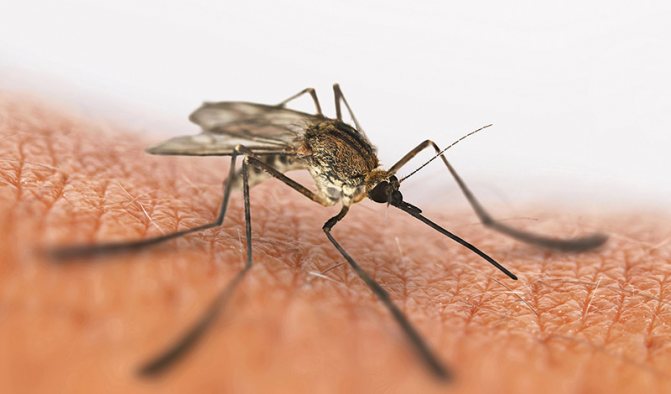
The word “allergy” itself is very ancient and came into modern speech from the Greek language. This word was first used as a medical term in antiquity. Greek doctors, when giving names to pathogenic processes, did not start from the cause of the disease or human condition, like the Latin ones, they sought to convey the very essence of the disease in the name.
This name appeared as a result of the merger of two words:
- ἄλλος – alien, different, other;
- ἔργον – influence, influence.
Of course, the doctors of Ancient Greece did not have the opportunity to study the mechanism of the appearance and development of the allergy process. However, ancient doctors defined its essence as accurately as possible and expressed it in the name of pathology.
The medical understanding of this process, as well as the definition given to it, has not changed its essence since ancient times. The allergy process is nothing more than an immune pathology, expressed in a deterioration of the general condition and local symptoms, arising due to the presence of hypersensitivity of the immune system to something. Accordingly, the causative agents of this immunopathological process are called “allergen”.
The following can act as an allergen:
- Any natural phenomenon, an example of this is seasonal reactions to the blossoming buds of trees.
- Specific substances that enter the respiratory tract, for example, dust or pollen.
- Food, drinks, medicines and other things that end up in the stomach.
- Ointments, creams, plants, materials - everything that a person touches; an example of this pathogenesis can be a reaction in the form of a rash and breathing problems when wearing woolen items.
- Insect bites and much more.
The nature of the occurrence and development of an allergic reaction is completely individual. In the same way, the list of probable allergens is individual - it is different for each person. Some people are sensitive to things and others are not. This pattern applies to all types of allergic reactions without exception, including those caused by bites of blood-sucking insects.
Mosquitoes
Children are more likely to suffer from allergies to mosquito saliva. An acute, severe, rapid reaction occurs. Swelling at the site of the bite does not subside within several days. The skin turns red and itches. Urticaria and a papular rash may appear. Often, a child scratches this area, introducing an infection into the wound, causing it to become inflamed.
With a strong reaction, the baby’s temperature rises, blood pressure drops, weakness and chills appear. This condition can lead to angioedema or anaphylactic shock.
What allergies do insect bites cause?
An allergic reaction caused by insect bites is called an “insect reaction.” The concept of insect allergy includes the consequences not only of bites, but also of any other influence of insects on the human body.
Clinical manifestations, externally noticeable signs and sensations of a sick person are completely individual. Insect allergies are the most dangerous, characterized by the presence of stages of development and are quite capable of causing death.
The severity of the patient’s condition with this type of allergic reaction directly depends on the following factors:
- Method of penetration of the allergen - in addition to bites, pathogenesis can be caused by particles of insect bodies entering the respiratory system or stomach, their contact with the skin, ingestion or on the skin of insect waste products, etc.
- The amount of allergen that enters the body - the severity of the immune reaction to the bites of a pair of midges and to multiple damage caused by a “cloud” of midges will be different.
- A type of insect - the body's reaction to a mosquito bite and a wasp sting is different; severe allergies are especially often caused by insects living in a different climate, that is, contact with locusts in Egypt or beetles in Asia can cause a painful condition in a person living in a temperate climate zone, even with no tendency to allergies.
- Age of the patient - in children, immune system reactions appear much more acutely than in adults, but they also pass quickly.
- The presence of chronic or other diseases - a sick person, for example, suffering from diabetes, tolerates insect bites much more difficult than a healthy person.
- Tendency to allergic reactions - if a person tends to react painfully to natural phenomena, products, dust or something else, then the likelihood of developing a severe form of insect allergy is many times higher than for someone who does not suffer from such a tendency.
The insect immune response cannot be ignored. Its distinctive feature is its gradual development in several stages. In the absence of therapy, in some cases, an immune reaction of this type becomes the cause of human death. It is especially dangerous to ignore such allergies in old age. A large amount of antibodies in the blood can not only provoke a state of anaphylactic shock, but also cause cardiac arrest.
Allergic reaction to insect bites: help and treatment
Communication with living nature brings a sea of positive emotions and a great mood. However, an encounter with the ubiquitous bees, wasps or bumblebees may turn out to be an unpleasant surprise.
Their stings are not only painful, but also dangerous. If you are allergic to insect bites, treatment is required immediately.
It is very important to know how to stay healthy when affected by these small flying creatures. In this article we will tell you what to do if an insect bite occurs; swelling and redness develop rapidly.
Who should you be afraid of and why?
In our parks and forests, in gardens and near rivers, working bees swarm, wasps feast on sweet fruits, fluffy bumblebees and hornets fly by. In the evening, mosquitoes become more active. Spiders and red ants are also dangerous. They are all ready to attack a person if they sense danger.
Microtrauma caused by “flying small things” can be extremely dangerous and result in a real threat to health. A lightning-fast response to them is no less important than assistance in case of a snake bite.
A violent reaction of the body can be provoked by:
- increased sensitivity,
- heredity.
Contacts with the winged “squadron” are dangerous, since poisons enter the hematopoietic system, which cause a rapid reaction of our internal defense mechanism – the immune system. For allergy sufferers, such “troubles” are especially dangerous, since the irritant substance tends to accumulate.
Also, “aggressors” produce specific components that indirectly affect the vital functions of human systems and organs. The shorter the time between bites, the greater the health risk.
For particularly sensitive people, a mosquito attack can be no less dangerous. Quick action is important if, after an insect bite, a red spot appears in a child or adult, accompanied by swelling, fever, lethargy, rapid and weak pulse, and headache.
Important: If a person is simultaneously attacked by more than 10 mosquitoes and a large red spot quickly “spreads” throughout the body, this can cause anaphylactic shock, causing swelling and suffocation.
Symptoms
The body's reaction to stings can be moderate to severe:
The main signs of moderate allergies:
- lethargy and weakness,
- pain and itching in the affected area,
- hives,
- nausea,
- vomit.
A severe allergic reaction is accompanied by the following symptoms:
- progressive swelling from an insect bite,
- anxiety and restlessness,
- difficulty swallowing,
- rapid increase in the area of the affected area,
- rash on the body,
- rapid pulse,
- labored breathing.
For allergy sufferers, first aid for insect bites is no less important than first aid for fainting. The painful condition can be aggravated by low blood pressure and lack of oxygen. Particularly dangerous are injuries to the face and neck.
Tissue swelling can cause the airway to close and may also lead to suffocation.
Mosquito injections are less dangerous, but children often react sharply to them. Monitor the condition of the victim. Breathing problems and swelling after a mosquito attack require urgent hospitalization.
We solve the problem ourselves
Allergy to insect bites - treatment should be started as soon as possible to prevent further deterioration of the condition and the occurrence of side effects.
So, first aid for bee-wasp-bumblebee stings
- Carefully inspect the affected area. If a bee stings and a sting remains, remove it immediately.
- Wash the wound with antiseptic soap. You can also treat it with a weak solution of potassium permanganate.
- Apply a cloth moistened with cold water or ice cubes to the affected area. Ice creates a cold environment around the wound. This helps to quickly constrict blood vessels, slowing down the spread of poison.
- It is advisable to take antihistamines to reduce swelling, itching, and redness.
We take medications from the home medicine cabinet
Treatment at home with antihistamines gives good results. These include diazolin, diphenhydramine, Telfast, Claritin. They have been tested for a long time, they can easily be bought in pharmacies without a doctor's prescription.
You can treat yourself and your family at home with the following pharmaceutical products:
- Hydrocortisone ointment - relieves swelling.
- Acetaminophen is a non-narcotic analgesic that relieves aching pain. Effectively relieves pain in the neck and face.
- Ibuprofen – will reduce the discomfort associated with bites.
- Aloe Vera gel will reduce irritation if, for example, a swollen arm or leg.
Advice: Always remember that it is unacceptable to use any medications without consulting a doctor.
Emergency medical attention is required for severe allergic reactions. Timely hospitalization can save a person from death.
The body is protected
If there is a threat of mosquito invasion, you can take azelastine, loratadine, cetirizine, ebastine. They will not repel mosquitoes, but will protect the body against “violent behavior”. A few drops of lavender or orange essential oils applied to outerwear can protect against flying pests.
Follow simple rules:
- When going out into nature or working in your summer cottage, be sure to use ointment against insect bites. Mosquito repellents for children will help protect your baby's delicate skin.
- Wear long sleeve shirts and pants when going out into the fresh air in the evenings.
- Avoid places where the buzzing “squadron” gathers. Stay away from hives and apiaries.
- Always carry insect repellent with you. Aerosols, creams, lotions are easy to purchase not only in a pharmacy, but also in a regular supermarket.
- Do not make sudden movements if “aggressors” are flying nearby, try to remain calm as much as possible.
- Wear clothes in green or white and brown shades. These colors do not attract pests.
- An effective tick repellent will also repel red forest ants and spiders.
- Do not use hairspray, perfume, cologne, or strongly scented soaps, as their odors are excellent bait for boogers.
Important: Some pest control products contain substances that are harmful to asthmatics and allergy sufferers.
When purchasing such products, pay special attention to their composition.
Proven traditional medicine
How to treat the affected areas for a quick recovery and prevent the development of allergies? We present to your attention harmless and proven recipes that have helped not only adults, but also children.
Why does this condition occur?
The question of why a painful condition develops in one person from the bite of a mosquito, flea, bedbug, bug or other insect, while another does not, has occupied people since time immemorial. Of course, this interest was caused by practical purposes - people wanted to protect themselves and their children from the consequences of contact with midges, mosquitoes, fleas, mosquitoes and other blood-sucking creatures.
The process of a specific reaction in the body caused by contact with an allergen is called “sensitization.” The term comes from the Latin word "sensibilis", literally meaning "sensitive". This term is used in various medical industries and not only in them.
In immunology and dermatology, the process of sensitization, that is, the occurrence of allergies, is caused by an increase in the body’s sensitivity to any type of exposure to irritants to pathogenic levels.
The period of sensitization is considered to be the period of time that passes from the moment an irritant enters the human body until the appearance of pronounced and clear signs of a painful condition. Thus, sensitization is a kind of incubation period for allergies that underlies this condition.

This process begins due to the hypersensitivity of the immune system to the presence of an irritant. Allergy itself is a disease; it is a pathology, a malfunction, an anomaly in the functioning of the human body, caused by individual characteristics.
Scientists have been arguing about the nature of the emergence of a tendency to such immune reactions for more than a century, but at the moment only the mechanism of occurrence of such reactions is known, and the reasons for the tendency to them are not entirely clear to scientists.
After an allergen enters the body, the immune system reacts to the potential threat, that is, it begins to produce antibodies. A similar process occurs when a person is infected with viruses, bacteria and other pathogenic organisms.
In insect immune reactions, the allergen is usually:
- Enzymes contained in insect saliva.
- Particles, fragments of their bodies, for example, a wasp sting.
The saliva and body fragments of bloodsuckers contain substances that are toxic to the human body. Accordingly, the immune system recognizes them as a threat and a protective reaction begins, that is, the production of antibodies.
In the absence of an immunopathological type reaction, an allergy does not develop. A person feels exclusively local symptoms that go away on their own. That is, a toxic enzyme that gets under the skin is “attacked” and “destroyed” by protective immune cells. As soon as the irritant is eliminated, local symptoms - itching, redness, induration, disappear on their own, and the human body gains immunity to the irritant.
This means that the next time you are bitten by the same insect, the symptoms will be much weaker and the bite marks will disappear faster. This feature of the functionality of the immune system explains why mosquito bites cause more pain in a newly born child than in older children or adults.
This is a normal typical reaction of the immune system to the penetration of an irritant. If this process goes wrong, an allergy occurs. Key points characterizing a pathological immune reaction:
- excessive, constant production of antibodies;
- continued production of antibodies and protective cells after the destruction of the irritant;
- lack of “memorization”, that is, the acquisition of immunity to the stimulus does not occur.
Thus, if a person has at least once encountered something that has caused allergic manifestations in his body, he should avoid such contacts throughout his life or take medications in advance before inevitable contact with the allergen.
The most effective ointments for bites

In order to get rid of ailments caused by an insect bite, many people use ointment.
The following remedies are considered the most effective:
- "Fenistil". The gel is suitable for adults and children. Has an antihistamine effect. Eliminates itching and inflammation.
- "Nezulin."
The cream has a natural composition. It can be used by children. Endowed with a bactericidal effect. Relieves itching. Contains substances that repel insects. - "Bepanten." It is used both for protection against mosquitoes and for treating bites. Characterized by anti-inflammatory and healing properties.
- "Advantan". The drug contains a hormone, which makes it act quickly and effectively.
- "Menovazin". Has cooling and anti-inflammatory properties. Contains menthol. Is an anesthetic.
- "Rescuer". Relieves irritation. Cures many diseases of the dermis. Must be in every...
How to distinguish allergies from the usual consequences of bites?
Not every redness on the skin, thickening or small rash are symptoms of an allergy. Moreover, an insect bite, stinging or other contact with it inevitably causes specific reactions. But not all of them need to be treated immediately.
Even if the bite mark looks scary, is large and itches a lot, you shouldn’t immediately reach for medication. Taking antiallergic drugs stops the process of developing immunity to the irritant. This means that if you take medications without actually having an allergy, the result will be an artificial formation of it.
Skin allergies caused by stings or bites are characterized not only by symptoms such as itching, redness, swelling or induration, but also by a number of other symptoms.
Pathologies that require treatment are in almost every case accompanied by the following symptoms:
- Increased body temperature, difficult to correct with medications that reduce fever.
- A severe rash that spreads beyond the site of the sting or bite, most often developing hives throughout the body.
- Spasms of the smooth muscles of internal organs, which cause cramping pain, for example, in the abdominal cavity, chest, back, or attacks of suffocation, difficulty breathing.
- Swelling of the subcutaneous layers and mucous membranes, severe redness and dryness of the latter, swelling, as well as the rash do not have a clear localization at the site of the bites.
- On the part of the digestive system - peristalsis disorders, usually diarrhea, and attacks of nausea are also typical.
Accordingly, stains left by mosquitoes or other insects are not an allergy and do not need treatment. In order to speed up the process of their disappearance, you just need to prevent scratching, that is, relieve the itching.

Of course, in addition to the general symptoms accompanying immunopathological conditions, there are also manifestations characteristic of reactions to specific insect bites.
| Type of insect | Duration of sensitization | Characteristic specific symptoms |
| Non-poisonous blood-sucking dipterans (horseflies, mosquitoes, fleas, bedbugs, mosquitoes and others) | From a few minutes to 2-3 hours | Rash – erythematous, vesicular, necrotic. Their appearance is usually preceded by urticaria and severe swelling. Also characteristic are manifestations characteristic of general intoxication of the body, bronchial spasms, swelling of the larynx and a high probability of developing Quincke's edema. |
| Non-poisonous lepidoptera and hymenoptera (bloodworms, some types of midges, butterflies, cockroaches, caddis flies, grasshoppers and others) | From several hours to 2-3 days | These insects usually do not bite; contact with them and especially with their waste products is dangerous. Allergies can also be caused by accidental ingestion of whole insects, their fragments and, of course, waste products. Characteristic symptoms are attacks of suffocation, rhinitis, swelling on the face, mainly in the form of swollen undereyes, dermatitis, which is outwardly similar to a nervous pathology, and not to an allergic rash. |
| Bees, bumblebees and wasps and other stinging | Immediately or within an hour | The development of symptoms occurs in three stages. The first stage is itching and burning, immediate swelling of the subcutaneous tissue, mucous membranes, including swelling of the tongue and larynx when stung in the throat, face, redness and purplishness of the damaged area of the skin. Later, general symptoms develop - fever, followed by a feeling of chills, a rapid increase in body temperature to critical levels, nervous excitement or, conversely, apathy, lethargy. This is followed by dizziness, loss of coordination, disorientation in space and time, and general weakness. The second stage is spasms and convulsions in the smooth muscles of internal organs, tremors of the limbs, twitching of the eyelids or other manifestations of nervous tics, difficulty breathing or a feeling of suffocation, diarrhea and nagging pain throughout the body, bloody discharge from the nose, genitals, and rarely the eyes. The third stage is a state similar to suspended animation, anaphylactic shock, coma and a high probability of death. |
| From 6 to 12 hours | Rapidly progressive generalized vasculitis affecting most blood vessels and vital organs. Demyelinating lesion of the nervous system. Disruption of neurochemical connections in the brain, expressed in an immediate decrease in thinking abilities, loss of the ability to build cause-and-effect relationships. Rarely – speech disturbances, drooling, hallucinations. | |
| Beetles (weevils, mealworms, blister beetles, redwings, weevils, ladybugs and others) | From 2 to 12 hours | These insects bite extremely rarely. Direct contact with their excrement and accidental ingestion of insects are dangerous for humans. Characteristic symptoms are acute intestinal disorders, with uncontrollable diarrhea, but with the absence of vomiting, vomiting is typical only in childhood, covering the body with a rash that looks like a diathesis crust. Subsequently, symptoms from the nervous system appear - convulsions, tremors, headaches. Following nervous manifestations, all the mucous membranes of the body dry out and turn red. |
Those insects that cause an immunopathological condition upon contact or ingestion are quite capable of biting a person. The bite in this case is not accompanied by blood sucking. In its place a blister forms, resembling a pinpoint burn. There is usually no itching, but there is severe pain when touched.
Bites cause immunopathological conditions with the same signs as contact or ingestion, but are characterized by less intense manifestations.
The main symptom of this type of allergy, of course, is skin rashes. Hives are far from the only form of rash that appears after an insect bite. Rashes can be:
- urticarial;
- vesicular, often leading to necrosis of skin cells;
- erythematous;
- papular;
- nodular;
- erysipelas;
- acne;
- mixed.
The greatest danger of developing a rash is the desire to scratch that accompanies it. Scratching blisters, spots or other types of rashes is often accompanied by the introduction of infections, usually staphylococcal, into the resulting wounds. This leads to the appearance and proliferation of areas of necrotic skin damage. Of course, after treatment in this case, marks remain on the skin.
A symptom such as fever is always present in immunopathological conditions. However, not in every case it is fever or fever. As a rule, the temperature increase is slight, within 38 degrees. However, its presence is constant, and the use of antipyretic medications is not particularly effective.
What to do if you are allergic to insect bites or effective methods for treating swelling and itching
In warm or hot weather, the first insects wake up. The most popular of them are butterflies, ants, beetles and, of course, mosquitoes. Wasps, hornets, bees and bumblebees pose a particular danger to humans, since in most cases they cause swelling and allergies to insect bites.
This phenomenon is explained by the fact that only 70% of the world's population does not develop an allergic reaction to proteins of various origins. These substances are part of the venoms of many insects, therefore, when the substance penetrates human skin, insect allergies and swelling develop.
A tumor as a natural reaction of the body to a bite
Swelling after insect bites occurs almost immediately or within a few minutes. There is no need to panic first, since such swelling is a common symptom along with vasodilation when a foreign substance enters a person’s skin.
If we compare all insects, then in most situations stinging species, including arachnids, pose a huge danger. Due to their bite, cells at the site of the lesion are destroyed and their contents flow out into other areas of the intercellular space. In addition, the human body fights back against the penetrated toxins, as a result of which swelling of the bite develops.
The poisons of insects such as wasps, bees and spiders provoke the destruction of capillary walls. Because of this, external bleeding begins. In rare cases, when several of the above-described individuals attack, internal bleeding occurs.
Therefore, slight swelling after the bite of insects such as mosquitoes, bedbugs, cockroaches, fleas, ants, midges and bugs is not dangerous to humans. On the contrary, this condition is the norm. The case is completely different if the entire limb is swollen - an arm or a leg.
We list the main symptoms and signs of edema, which are the norm with an insect bite:
- Increased temperature in the affected area.
- There is a slight itching sensation. Moreover, the swollen red spot should not be scratched.
If additional signs appear, you should urgently consult a doctor for advice.
When to fight a tumor
When is inflammation from an insect bite dangerous for humans? In some cases, even a harmless bug can cause a lot of particularly dangerous consequences, including the development of anaphylactic shock or Quincke's edema.
Oddly enough, but irritation and inflammation on the skin can appear due to an ordinary ant. For a person, forest pests are able to enter his home and bite him, during which an allergy occurs, the common symptoms of which are itching and redness. In rare cases, the bite results in widespread swelling, hives and anaphylactic shock.
The main signs and manifestations of allergies are endless itching, swelling of the limbs and redness.
If you do not seek medical help in time, consequences such as infection in the areas of scratching and Quincke's edema may develop.
This leads to allergies and inflammation in the skin layer at the site of the bite. This situation occurs if a person with allergies is bitten by a bee or wasp.
Blood-sucking insects are also dangerous. Bedbugs, fleas and mosquitoes cause swelling and redness in the affected area. In addition to these systemic manifestations and symptoms, there is a risk of contracting diseases that these insects carry.
In addition, arachnids still live in a person’s home. Ticks and centipedes transmit leishmaniasis, malaria and encephalitis. Wasps, bumblebees and bees often enter the apartment through the window. The bite of these individuals causes difficulty breathing in the allergic person, which can lead to asphyxia. Therefore, in this case, you must immediately call an ambulance.
First actions after a bite
If a leg or arm is swollen, edema forms, all jewelry is immediately removed. After this, it is necessary to remove the insect sting and the liquid that got under the skin from it. Any hard object will do to remove the poisonous sac. The remains of the insect are scraped off.
People without an allergic reaction should take one antihistamine tablet to prevent swelling or swelling. After this, a bandage is applied, previously lubricated with ethyl or ammonia and water.
If the entire leg is swollen, a bandage is applied to the entire limb. In children, a bite can cause a more life-threatening condition. Therefore, if a child is stung by a bee, parents immediately consult a doctor.
We recommend further reading: Swelling after an encephalitis tick bite
If an insect bite appears in the eye or near the eyelid, the same thing is done as described above.
Effective treatment
How to treat insect bites? The sections below describe in detail instructions for the use of medicines and folk remedies if a compaction in the form of a tumor or edema appears under the skin.
Drug therapy
Allergy to insect bites is often treated using the following medications:
- The development of allergies and edema is prevented primarily with antihistamines (cetrin, clemastine, suprastin).
- Also excellent antiallergic drugs are analgesics. They are prescribed by a doctor if the patient has symptoms such as pain, itching and swelling. Allergy pills are usually prescribed. The fastest way to relieve allergic reactions is with intramuscular drugs - Analgin and Baralgin.
- Hormonal drugs – Prednisolone in tablet and injection form – are also considered an excellent cure for allergies and swelling.
Ointments and sprays
An allergic reaction to insect bites in most cases results in severe itching and redness. How to relieve itching in this case?
Typically, special creams and ointments are used to get rid of these symptoms:
- Fenistil.
- Flucinar.
- Levomekol.
- Advantan.
Anti-itch gels are used without a prescription. In this case, the main thing is to take into account the contraindications that are indicated in the instructions for the medicinal product. Other medications are taken only after a visit to the doctor.
Folk remedies
How to relieve swelling using traditional medicine? Let's consider the most popular ways to relieve itching and swelling even in babies and small children using folk remedies:
- The chewed consistency of plantain is applied to the affected area.
- If you don't have an antiseptic or antibacterial agent on hand, you can wash the wound with urine.
- You can apply clean parsley leaves to the site of swelling. This garden plant easily eliminates pain and swelling. It is recommended to take a decoction of parsley roots internally. To prepare, you will need 2 teaspoons of dry plant and 0.5 liters of boiling water. The broth is brewed overnight in a thermos.
- Extract the juice from the mint and apply the resulting mixture to the area where the bee or wasp stung. This procedure will eliminate pain, prevent inflammation and relieve swelling.
- To disinfect the bitten area, the bulb is cut and attached with a bandage to it. The compress remains overnight. You can also wipe the swelling area with onion juice.
Insect allergy prevention and precautions
It is better to prevent swelling after an insect bite immediately. In addition, stores sell special products that protect against insect attacks.
Source: https://OtekOff.ru/otek/otek-ot-ukusa/allergiya-na-ukusy-nasekomyh
How are such conditions classified?
Allergic reactions to stings, bites and other types of effects of insects on the body are classified simply, based on the prevailing symptoms. It is quite possible to determine the type of immunopathological reaction independently, at home, by being attentive to the sensations experienced and externally noticeable signs of pathogenesis.
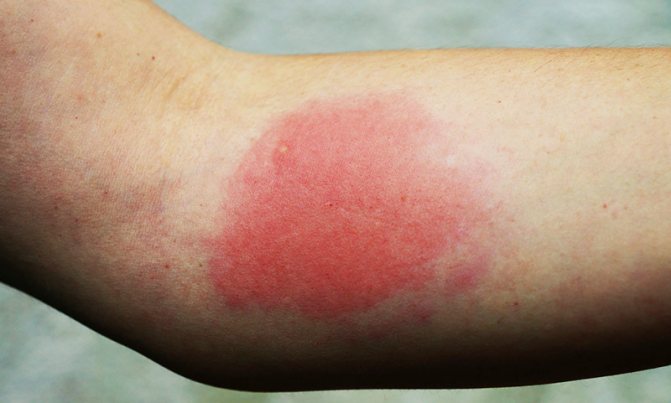
Insect allergies are divided into:
- Toxic.
- Mechanical.
- Mixed.
In the first case, the predominant symptoms are caused by the presence in the body of a toxic enzyme secreted by insects.
In the second case, the manifestations of pathology are dominated by the consequences of mechanical damage. That is, this type of pathogenesis can develop as a result of multiple bites. For example, if a person was bitten by a flock of midges or he spent a summer evening near the water and was repeatedly bitten by mosquitoes. In this type of pathology, insect toxins are not important, since the victim has immunity to them.
Mixed reactions occur after multiple bites in the absence of immunity to the enzymes injected by insects. In addition, this type of pathogenesis can develop in the presence of several stimuli. For example, if a person at one time was bitten by mosquitoes, horseflies, a flock of midges, gadflies or other insects.
With a multiplicity of irritants, an allergic reaction occurs even in people who have immunity, who are, in principle, not prone to immunopathological processes.
Determining the type of pathogenesis, that is, which symptoms predominate, is extremely important. Based on the symptoms experienced, the drugs needed for treatment are selected. That is, with a more pronounced mechanical reaction - profuse rashes, severe itching, swelling in places of damage, and not general, medications are required that act locally and do not affect the body as a whole. If there are symptoms of general intoxication, medications that effectively cleanse the blood are needed.
Antihistamines for insect bites
we were praised for Erius.
But what confuses me with Erius is that it is for children over 12 years old.
Don’t even know where to go.
Quiet at all. It seems like they don’t even bite other children :)) *jealous*
Why lubricate with brilliant green? However, what difference does it make, I’m ready for the green stuff if it helps, and if my daughter doesn’t oppose this event :)
*went off to study about Gistan*
In my case, Tai has these bumps with redness around them that appear as a result of mosquito bites - on the second or third day.
I poured my own Claritina today. Let's see what happens:)
What do you use to smear yourself against “animals” in nature? Summer is coming, the child must be sent to the village, and we are all looking forward to this period with horror, because we need to somehow protect and save the child, but it is not yet clear how. All anti-mosquito ointments for children have such a minuscule concentration of the active substance that they don’t seem to help much.
I really, really believe that all this is not a scam, that finally there is a way that will scare these infections away from the child.
While I’m smearing my youngest with a lot of mosquito repellent (I have an adult liquid, children from 3 years old can use it)
, so your daughter can do it all the more), I tie a mosquito bracelet to my cap.
I winced at the syrup today, but courageously swallowed the spoon. I will hope that this is our salvation :)
Now I’ll study mazyukalki. I'll be fully prepared for summer :)
How to quickly get rid of insect bites, and how to protect yourself from them? Read more in our article.
Insect bites are not as harmless as they seem at first glance. They can cause both local inflammatory processes and severe toxic reactions.
For example, with idiosyncrasy (hypersensitivity to bee venom), even one sting can lead to a severe allergic reaction, which is accompanied by fever, urticaria, vomiting, Quincke's edema, a sharp decrease in blood pressure and pain in the heart, joints and lower back.
In our latitudes, the bites of the hornet wasp, the gadfly, the bumblebee and the honey bee are especially dangerous. And if you have become a “victim” of insects, then you may need some medications to alleviate the adverse effects.
Wound healing and antiseptic agents
If a wound has formed after a bite, then it is necessary to treat the bite site with external antiseptic agents (available in the form of aerosols, gels, ointments). This procedure will prevent the spread of bacteria, in particular staphylococci and streptococci. Wound healing agents (for example, preparations based on panthenol) accelerate regeneration processes after a bite.
Anti-inflammatory and painkillers and antihistamines
As mentioned above, an insect bite can lead to an inflammatory process, as well as the development of an allergic reaction. Therefore, the “arsenal” of remedies for insect bites should include anti-inflammatory, painkillers and, in case of allergies, antihistamines.
To relieve inflammation, non-steroidal anti-inflammatory drugs with local action, such as ointments, creams or gels, are suitable. As for anti-inflammatory drugs based on glucocorticoids, these drugs, as a rule, are only available with a doctor's prescription.
Local preparations based on non-narcotic analgesics are used as painkillers. A number of painkillers also have an antipruritic effect, which is very important in the presence of skin irritations.
The use of antihistamines is justified in case of an allergy to an insect bite. Therefore, if you are predisposed to allergies, then you need to take these drugs orally as soon as possible. There are also local antihistamines (ointments, gels) that should be applied to the affected area, especially in the most sensitive areas (neck, face).
How to prevent a bite?
Of course, it is best to prevent any problem rather than deal with its consequences. In order to avoid becoming “prey” for insects, you can use special repellents.
Most repellents are made with diethyltoluamide (DEET), a substance that irritates insect antennae. As soon as an insect smells DEET, it tries to fly as far as possible from the source of the repellent.
The most effective way to apply such products on the body is to eliminate the smell of sweat, which attracts insects. However, not all repellents can be applied to the body. Therefore, read the instructions carefully before use!
There are also products based on essential oils of eucalyptus, lemon, catnip and other plants. However, the effect of natural repellents is short-lived (only about an hour), and in some cases they are completely ineffective.
Repellents offered today come in different forms. These can be aerosols for spraying indoors, creams, ointments, and repellent sticks. Aerosols are the most convenient to use, but they last a relatively short time (2-5 hours) due to the low concentration of active substances. Do not spray the aerosol on your face or damaged areas of the body!
Repellents in the form of milk can be applied to large areas of the body. The milk is well absorbed and does not leave behind a sticky film. The duration of action of such a repellent usually lasts 3-5 hours.
The longest action time for creams and ointments is about 10 hours. In addition, repellents in this form are less toxic; in addition, among them there are special products for children, in which the content of active ingredients is reduced.
And finally: always buy insect This way you will purchase a certified product that has passed dermatological control.
Instructions for medications
Source: https://stop-allergies.ru/antigistaminnye-preparaty-pri-ukusah-nasekomyh/
Is insect allergy diagnosed?
Most people diagnose themselves with “allergy”, and such self-diagnosis does not always reflect the actual state of the body. Dermatologists often encounter in their practice situations where skin diseases that have nothing to do with the immune system are mistaken for immunopathological processes.
Self-diagnosis can be extremely dangerous, especially during pregnancy, the development of pathology in a child, or in old age. Only a doctor can assert that painful sensations or specific manifestations are associated with disturbances in the functionality of the immune system, based on the results of diagnostic procedures and studies.
Like any other disease, allergies are diagnosed by doctors based on a combination of:
- taking anamnesis;
- obvious clinical picture;
- results of allergological tests and examinations.
Allergy testing typically includes:
- “PACT” is a radioallergosorbent test needed to determine specific IgE to insect allergens.
- Basophil testing according to Shelley.
- Serological studies revealing the presence of an immune complex type reaction.
If necessary, doctors prescribe other studies, tests, tests and procedures.
Signs of an allergic reaction
Each person experiences an insect bite differently. Today, there are 3 types of reactions – moderate, local and acute allergic reactions.
A moderate allergic reaction to an insect bite manifests itself in swelling of the bite site, pain or burning, and severe itching at the site of the bite. Usually after a few days the swelling and itching subside.
A local allergic reaction can be very dangerous if an insect stings a person in the mouth or larynx. This can lead not only to hives, but also to a sharp drop in blood pressure, swelling of the larynx, difficulty breathing and swallowing, nausea and vomiting. This condition is especially dangerous for older people due to the possibility of suffocation from Quincke's edema, which can lead to death.
An acute allergic reaction (anaphylactic reaction) usually occurs 10-20 minutes after the bite and lasts up to 4 hours. The earlier it appears, the more severe it becomes. For example, if the reaction occurs a few minutes after the bite, then in almost 40% of cases this leads to death.
The main signs of an allergy to insect bites can be described as follows: the appearance of hives, sometimes throughout the body, difficulty breathing, shortness of breath, a sharp drop in blood pressure, dizziness, loss of consciousness, swelling of the bite site, and a feeling of anxiety. Such reactions do not occur often, but require immediate medical attention, because can lead to death.
Negative symptoms after an insect bite may differ in nature and severity:
- local allergic reaction (pain, swelling, hyperemia, itching);
- generalized manifestations in the form of rhinitis, conjunctivitis, fever, urticaria, respiratory failure, pain in the heart and head, fainting.
Insect sting allergy symptoms (photo below) can become more unpleasant and severe, occurring within minutes or hours:
- swelling increases in diameter and does not decrease during the day;
- blisters or bubbles with liquid form;
- a rash appears all over the body;
- the temperature rises, which indicates the beginning of an inflammatory process;
- manifestations of lethargy, weakness, dizziness;
- runny nose and drooling appear.
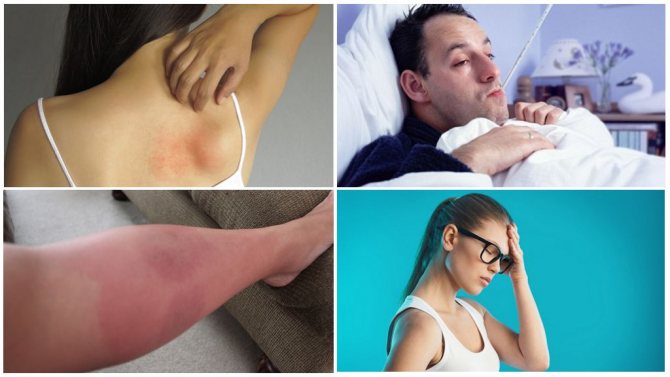
The most severe reactions include:
- Quincke's edema - manifests itself in extensive swelling of tissues, including the mucous membrane of the larynx and tongue, which blocks the access of air and suffocation; the patient may suffocate from asphyxia;
- anaphylactic shock - occurs when blood circulation is impaired under the influence of releases of serotonin into the blood, manifested by severe pain in the affected area, swelling of tissues, difficulty breathing due to bronchospasms, disturbances in heart rhythms and a sharp drop in blood pressure, the skin becomes bluish, loss of consciousness is possible;
- angioedema - manifested by neurological symptoms: decreased response of the limbs, partial paralysis and convulsions.
There are two types of symptoms: local and generalized.
- Local manifestations include:
- hyperemia of the bite area;
- compaction;
- swelling;
- severe itching;
- burning;
- soreness;
- rash.
- Generalized manifestations:
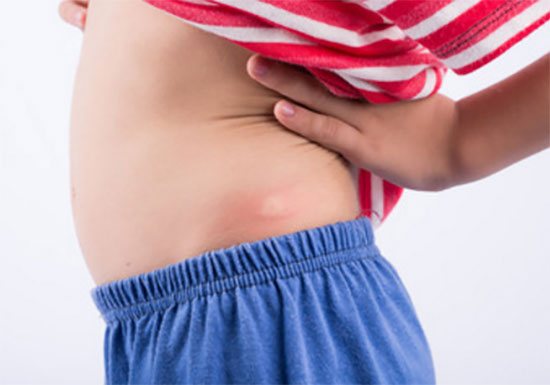
Reaction to mosquito bite
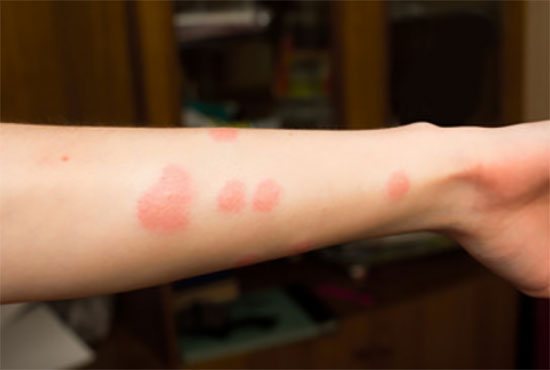
Allergy to flea bites
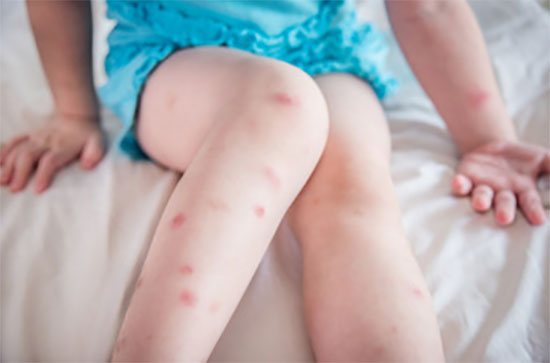
Mosquito bites
In rare cases, a similar condition may develop. Therefore, it is so important to know how it manifests itself, because it poses a serious threat to the body and life of the baby.
Characteristic symptoms of anaphylactic shock:
- labored breathing;
- arrhythmia;
- fainting;
- severe hypotension;
- vomit;
- feeling of swelling in the throat;
- tightness in the chest;
- swelling of the face, throat;
- shock leading to death.
Blood-sucking insects are widespread and ubiquitous; people are exposed to their bites not only in the forest, in the taiga, near rivers, but also on the streets of large industrial cities.
These include representatives of the order Diptera: mosquitoes, midges, midges, mosquitoes, horse flies. Females lead a predatory lifestyle. Blood-sucking insects are carriers of pathogens of many infectious diseases.
Mosquitoes - malaria, yellow fever, Japanese encephalitis, encephalomyelitis. Midges – Japanese encephalitis, equine encephalomyelitis. Midges - smallpox, leprosy, anthrax, plague, tularemia. Mosquitoes – pappataci fever, cutaneous and visceral leishmaniasis. Horseflies - polio, anthrax.
Squeaker mosquito. The squeaking mosquito inhabits all continents: to the north it reaches the Arctic Circle. Belongs to the genus of squeakers (Culex).
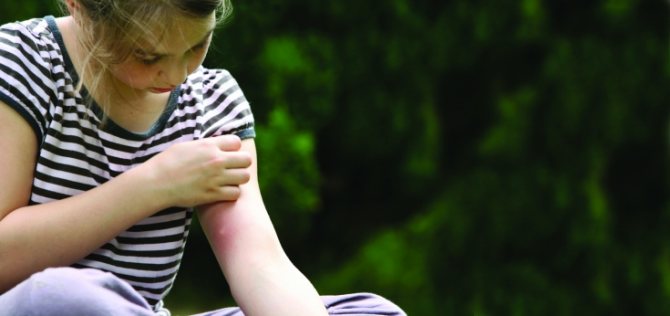
Kuska two-lane
The two-lined biter (Aedes) is the most numerous genus among blood-sucking mosquitoes in terms of the number of species. There are especially many biters in the forest zone and in the tundra. The high number of mosquitoes in these places is explained, first of all, by the fact that there are many reservoirs suitable for the development of larvae.
In addition, female biters, even without fully sucking blood, can already lay some eggs. Thus, it is the biters that everyone encounters when they find themselves in the forest or tundra in the summer.
Common malaria mosquito
Common malaria mosquito (Anopheles maculipennis). Compared to the more humpbacked and thicker biters and small squeakers, the common anopheles mosquito, like other mosquitoes of the Anopheles genus, is noticeably slimmer, with longer legs.
Sitting mosquitoes can also be distinguished by their posture: in malarial mosquitoes the abdomen is directed upward at an angle to the surface on which the mosquito is sitting, while in non-malarial mosquitoes it is parallel to the surface or even downwards. The main vector of malaria pathogens. Distributed throughout Europe, except the tundra.
Everyone knows that mosquitoes cause a lot of suffering to people and animals. But not everyone knows that only females show such importunity, and only after mating. Males are content with the juices of various plants. Saturation of females with blood is necessary for the development and subsequent laying of eggs.
But at the same time, females pose an epidemiological danger to humans and animals. Having drunk blood for the first time on a sick person or animal, when they suck blood again, they introduce the causative agent of an infectious disease into the blood of a healthy person with saliva.
Blood-sucking mosquitoes go through four developmental phases: eggs, larvae, pupa and adult (winged) insect.
The life of eggs, larvae and pupae takes place in water. It takes about a week from the egg stage to the formation of the imago (adult). The males always appear first. Not far from the breeding sites, they gather in swarms, waiting for their “brides.”
In fertilized females, the blood-sucking instinct awakens. A hungry female is able to find large concentrations of animals and people at a distance of up to 2-3 km. During one act of sucking, the female drinks an amount of blood that exceeds the initial weight of her body.
After laying 150-200 eggs, the female becomes aggressive again. Having re-fed blood, she again loses interest in food until the next batch of eggs matures and is laid. The female lives on average 30-40 days. After each egg laying, a significant part of the mosquitoes die.
Little midge (Culicoides pulicaris)
Small dipteran: body length 2.3-2.5 mm. His chest is grayish on top, with two dark longitudinal stripes. The wings are gray with light spots. Females feed on the blood of humans and animals. The larvae develop in a humid environment and in shallow ponds overgrown with mud. Distributed almost everywhere in extratropical Eurasia.
Spotted Odagmia (Odagmia ornata). The body length of this midge is about 2 mm. The chest has a distinct horseshoe-shaped pattern on top. Larvae are common in rivers. Distributed throughout Europe and Siberia, a massive bloodsucker.
River midge (Simulium galeratum). A small fly, about 2.5 mm long. Her abdomen is black on top, and there are silver spots on her black chest. The larvae develop in medium and large rivers. Females feed on the blood of humans and animals. Distributed in Europe and Siberia.
In appearance, midges really look like tiny flies: their average size is 2-3 mm and they are never larger than 6 mm. They are distinguished by shorter, stronger legs and a short trunk. The wings are colorless, wide, and at rest fold horizontally one above the other.
The females of most midges are vicious bloodsuckers, feeding on the blood of large animals and humans. In the forest belt in summer, near streams and rivers, one person can often be attacked simultaneously by several thousand midges. They often penetrate under clothing and bite covered parts of the body.
Midge bites are very sensitive - as if you were hit by a hot needle. When the skin of a person or animal is punctured, midge saliva containing painkillers is injected into the wound.
That's why you don't feel pain at first. But after some time, when the midge has already sucked blood and flies away, a feeling of strong burning, tingling, itching and pain appears at the injection site, and swelling develops.
On hot days, midges are especially rampant in the morning and evening, and in cloudy weather in the middle of the day. In northern latitudes, during the white nights, midges “work” around the clock. They subside only at night, as well as in rainy or windy weather. Midge larvae, unlike mosquito and midge larvae, develop in fast-flowing rivers and streams. Therefore, there are especially many midges where there are fast-flowing waters.
The swelling from a midge bite is much greater than from a mosquito bite, and so is the pain. This is due to the fact that when attacked, the midge does not pierce, but gnaws out the skin. There is an advantage to this - it is not capable of biting even through thin clothing. The saliva of midges contains anesthetic substances.
The pain after a bite, indeed, goes away quite quickly, but then the hemolytic poison contained there, in the saliva, comes into effect: itching, burning, intradermal hemorrhage occurs, then swelling and even point necrosis. Children usually scratch the bite area until it bleeds until ulcers appear.
With multiple bites, and with individual sensitivity even after one, after 3-5 hours symptoms of general intoxication may appear: the temperature rises to 38-39 degrees, chills, weakness, tachycardia, pain in muscles and joints, and headaches begin.
How to treat?
As a rule, those suffering from a specific reaction of their own body caused by insect bites ask doctors to prescribe them some pills that do not cause drowsiness. But not every case of allergy can be treated with tablets; for example, when symptoms of the mechanical type predominate, the use of local external agents is sufficient.
In the treatment of allergies that require the use of medications, the following are used:
- "Diphenhydramine" - for severe disturbances in nervous activity;
- "Suprastin" - if necessary, blood purification;
- "Tavegil" - for mixed symptoms.
In addition to these drugs, therapy uses medications to compensate for the calcium deficiency that occurs during pathogenesis, as well as analgesics to relieve the severity of burning and pain. Any ointment containing glucocorticoids is used as a local remedy.
The greatest difficulties are caused by the treatment of bullous type rashes. With this type of rash, it is necessary to open each blister, wash the wound with a disinfectant and then treat it with ointments containing antibiotic or antibacterial components.
Therapy for pathogenesis that develops after an insect sting is carried out differently. Treatment includes several main stages:
- When removing a sting from the skin, it is important not to break it or leave fragments.
- If the location of the sting allows, it is necessary to apply a tourniquet above the wound, similar to what is done after snake bites.
- The affected area is injected with a solution of adrenaline at a concentration of 0.1% and a total volume of 0.3-0.5 ml.
- Following the injection, 0.3-0.6 ml of adrenaline solution is injected subcutaneously or intramuscularly.
- Adrenaline injections are repeated at intervals of 10 to 20 minutes until the victim emerges from the collapsing state.
In addition to adrenaline, injections are used in therapy:
- cordiamine, one-time, in a volume of 2 ml;
- solution of caffeine with sodium benzoate, one-time, in a concentration of no more than 10% and a volume of 1 ml.
Injections are carried out subcutaneously or intramuscularly. Treatment is supplemented with injections of antihistamine solutions:
- "Diphenhydramine", at a concentration of 1% and a single dosage of 2 ml.
- "Suprastin", at a concentration of 2%, 2 ml at a time.
- "Diprazine", at a concentration of 2.5% and a single dosage of 2-2.5 ml.
If necessary, the course of therapy includes corticosteroid drugs:
- "Prednisolone";
- "Hydrocortisone hemisuccinate";
- isotonic sodium chloride solution.
In case of severe spasm in the respiratory organs, the victim is injected with "Eufillin" in a solution with glucose. As a rule, the solution is prepared in a 1:1 ratio from a 2.4% Eufillin solution and a 40% glucose solution.
Antihistamines in tablets are taken in the dosage recommended by the doctor or in strict accordance with the instructions prescribed in the pharmaceutical annotation.
Medicines are not always required to treat allergies caused by insect bites. Folk remedies are also effective, of course, if we are not talking about stings by wasps, bumblebees, and bees.
The best folk method of combating allergies accompanied by rashes, swelling and other similar manifestations is the use of decoctions of parsley and celery roots. A decoction of parsley quickly cleanses the blood, and a remedy prepared from celery root reduces the activity of antibody production and copes with most of the obvious symptoms of the disease.
The proportional ratio of healing raw materials and water directly depends on the severity of a person’s condition. The worse the patient feels, the more root should be in the decoction. As a rule, a proportion of 1:3 is used, that is, 1 part of rhizomes requires 3 parts of water.
The decoction is prepared for 10-20 minutes; the drier and older the raw material, the longer it takes to boil. You need to take decoctions from 3 to 8 times a day, depending on the intensity of painful manifestations.
Using folk remedies you can relieve the itching after a bite without waiting for it to appear. That is, apply a compress with a cold infusion of chamomile or any other plant that has antiseptic properties to the damaged area.
In the absence of plant materials, the bite sites should be washed with soap and then treated with boric acid or a compress of potassium permanganate applied to them. These simple steps will prevent a strong burning sensation and almost completely stop the desire to scratch.
Video: allergy to insect bites.
Insect bites: allergic manifestations and their treatment
A person encounters insect bites several times in his life.
For some, this is a common occurrence that does not cause much discomfort, for others it is a serious problem requiring medical intervention. Some cases of bites are even fatal.
Therefore, it is necessary to know the possible consequences of contact with insects, first aid methods for bites and treatment principles.
Consequences of insect bites
The bite of any insect causes a certain reaction in the human body. The degree of its manifestation depends on two factors: the type of insect and the health status of the bitten person. A bite from a poisonous species can have serious health consequences and requires urgent medical intervention.
Non-venomous insects most often do not pose a threat to life, but in some cases even they cause a serious allergic reaction. This is due to the peculiarities of the immune system of the bitten person and his tendency to allergies.
If the victim is allergic, then even the bite of an ordinary midge or mosquito can cause significant swelling, rash and increased body temperature.
Local allergic reaction
When a person has developed immunity, and the insect that bit him was non-poisonous, local allergies of varying severity are observed. It may appear as swelling, redness, swelling and itching at the site of the bite.
Such symptoms are provoked by bites of spiders, bedbugs, midges, bees, wasps, bumblebees, hornets and ticks. Allergies develop as a reaction of the body to foreign agents that, together with insect saliva, penetrate human tissue.
Itching can also occur during the healing of a wound caused by an insect sting.
Sometimes a lump forms on the skin at the site of the bite. It occurs for several reasons:
- the immune system cannot cope with the neutralization of toxic substances from the insect’s saliva and an infiltrate occurs;
- an infection has entered the wound formed after the bite;
- under the skin, the larvae of an insect that has bitten a person develop (typical of gadflies).
After an insect bite, the lymph nodes may become inflamed and enlarged. This is a reaction of the lymphatic system that prevents infection from spreading throughout the body.
Systemic allergic reaction
A more severe degree of allergy, which is provoked by the bites of hornets, wasps, bees, bumblebees and other stinging insects, is a systemic reaction of the body. Its consequences are:
- a red rash in the form of spots or papules that can spread to areas of the skin far from the bite;
- swelling - affects not only the areas affected by bites, but also other parts of the body. The greatest danger is swelling of the respiratory tract, as there is a risk of suffocation;
- anaphylactic shock is a rapidly developing allergic reaction, which is characterized by a sharp decrease in blood pressure, loss of consciousness and cardiac arrest. It can occur with multiple stings from stinging insects, most often hornets.
First aid for insect bites
Regardless of the severity of a person’s condition after an insect bite, it is necessary to take a number of precautions so that his well-being does not worsen. First of all, on this day you should give up smoking, alcohol and active movements.
All this causes dilation of blood vessels, and, therefore, will increase the rate of spread of toxic substances throughout the body. For the same reason, you should not heat the bite site. Further actions are limited to limiting the area of inflammation.
To do this you need:
- Cool the bite area and apply pressure with a bandage.
- If a large number of bites are concentrated on the arm or leg, then the limb is elevated to relieve swelling.
- Disinfect bites with iodine, alcohol or another antiseptic.
- Use any solution that relieves itching and swelling (laundry soap, soda, salt, etc.).
- Take an anti-allergy drug - diazolin, loratadine, suprastin, etc.
An hour after first aid has been provided to the victim, it is necessary to assess his condition and draw up a plan for further action. In cases where there is a severe allergic reaction with a significant deterioration in a person’s condition, there is a possibility that he was bitten by a poisonous insect. Then the patient should be urgently hospitalized.
Treatment of allergic reactions
If an allergy to insect bites occurs, treatment can be carried out with folk remedies and medications, depending on the severity of the symptoms. After first aid, available medications are used.
Traditional medicine recipes
Sometimes an allergic reaction develops very quickly, and it is necessary to eliminate the symptoms urgently. Then the best treatment options are those that can be prepared from natural ingredients or things that are found in every home. The following recipes are effective:
- Water. Even simply washing the bites with cold water helps relieve itching and swelling.
- Soap solution. Prepare a concentrated mixture of water and dark laundry soap. Bandages soaked in this solution relieve itching, redness and bumps at the site of the bite.
- Lotions and rubbing with tea. You can use both regular black tea and medicinal teas.
- Apply a fresh dandelion leaf to the wound and fix for 3 hours. Then replace the sheet with a new one.
- Add 1 teaspoon of salt and/or soda to a glass of cool water. You can wipe the bitten areas with this solution or make lotions with it. A slurry of soda powder is also used. It helps with scratching and swelling.
- Toothpaste or ointment with menthol. The cooling effect of menthol relieves burning and itching. But this ointment should not be applied to open wounds.
- A solution of vinegar and water in a 1:1 combination. Used to wipe bites or lotions. The compress can be left on for 30–40 minutes. After this, you need to take a break for several hours. Before the next procedure, the skin is wiped with alcohol. The vinegar solution helps get rid of swelling at the site of bites.
- Concentrated decoction of dried leaves and stems of Veronica officinalis. Can be used to wipe the affected skin or make compresses for 2 hours. The area covered with the compress should be wrapped with a bandage or polyethylene. Veronica officinalis has an antiallergic effect and is able to relieve inflammation after bites of spiders and almost all insects.
- Onion juice. Half an onion is applied to the bite site or a compress is made from finely chopped onion.
- Parsley leaves are crushed until the juice is released and applied to the affected skin.
- To reduce inflammation, swelling and swelling, bite sites are wiped with a solution of ammonia, boric or ethyl alcohol diluted with water in equal proportions. You can make lotions from boric acid, which are replaced as they dry. Rubbing the bites with iodine helps reduce bumps.
- A paste of plantain leaves is placed on the bite and secured with a bandage.
- Add 1 tablespoon of dry St. John's wort, mint and oak bark to two glasses of boiling water. The mixture is boiled over low heat for about 15 minutes and filtered. Cold decoction is used to make lotions.
- A cabbage leaf paste is applied to the bite sites.
- Make a mixture of oils: 1 tablespoon vegetable, 5 drops lemon and 5 drops mint. Soak gauze in the oil mixture and apply to the bite. Cover the bandage with polyethylene and secure with a bandage.
Medications
Among the medications that are used to eliminate the consequences of insect bites, preference is given to ointments and gels. But in serious cases, it is necessary to take pills or inject drugs to relieve pain and inflammation. Treatment of allergies caused by insect bites may include the following groups of drugs:
- Antihistamines – reduce swelling and itching. For example, fenistil gel, Benadryl, tavegil, loratadine. For large bumps at the site of the bite, they are prescribed in combination with antibiotics, such as azithromycin, ciprofloxacin, amoxiclav.
- Glucocorticoids – reduce swelling and inflammation. For example, flucinar, sinaflan, prednisolone and hydrocortisone ointments.
- A complex of antibiotics and glucocorticoids - prescribed for swelling, bumps, infections at the site of the bite, and significant inflammation. For example, kremgen, trimistin, hyoxyzone, triderm.
- Antibiotic ointments - reduce inflammation and infection, prescribed for suppuration at the site of the bite. For example, oflocaine, levomekol, levosin, syntomycin.
- Corticosteroids – have an analgesic effect and reduce swelling. For example, prednisone.
- Non-steroidal anti-inflammatory drugs – eliminate pain, fever, inflammation. For example, acetaminophen, aspirin, ibuprofen.
- Antiseptics – relieve itching and pain. For example, menovazin.
Sometimes the doctor prescribes a compress from several groups of drugs. For example, a compress based on dimexide works well to relieve puffiness and swelling at the site of a bite. To do this, it is diluted with water in a ratio of 1:4 and an antibiotic, hydrocortisone ointment and heparin are added. A compress from the resulting mixture is applied to the affected areas for 2 hours.
In case of a systematic allergic reaction with difficulty breathing, the following remedies are used:
- epinephrine injections;
- glucocorticoids and diuretics to relieve edema, for example, hydrocortisone, furosemide;
- antihistamines;
- corticosteroids;
- drip administration of oxygen;
- tracheostomy or tracheal intubation.
If anaphylactic shock occurs, the victim is hospitalized, and measures are taken to restore cardiac activity and breathing:
- cardiac massage, artificial ventilation;
- administration of adrenaline or epinephrine;
- use of glucocorticoids, antihistamines, corticosteroids, bronchodilators;
- intravenous infusion of colloidal and saline solutions to normalize blood pressure.
Long-term therapy
When a person knows that he is allergic to certain insect bites, he needs to protect himself as much as possible. To do this you can do the following:
- Use repellents, for example, off, autan, glorus. You should avoid places where insects accumulate, wear clothes that cover your body as much as possible, and do not use overly aromatic cosmetics and perfumes.
- Carry a first aid kit containing first aid medications for allergies.
- Learn how to inject yourself.
- Purchase medical identifiers - a bracelet or pendant. They will contain information about the characteristics of allergies and will help doctors in providing first aid.
These techniques are especially important to follow in relation to children. If the child is small, then it is necessary that in his environment there are people who know about the presence of allergies and are able to provide first aid.
If a person has repeatedly experienced a systemic allergy, or an extensive local reaction that worsens with each new case, it is useful for him to undergo a course of immunotherapy. This can prevent the development of an acute allergy the next time you are bitten by an insect.
Allergic reaction to a midge bite
Such a small insect as the midge is also dangerous, especially for allergy sufferers. There are almost 2000 species of different midges. Their saliva is toxic to human tissue to varying degrees.
Very often the victim does not even immediately notice that he has been bitten. This happens because, firstly, the insect is very small, and secondly, when it bites, the midge introduces an anesthetic into the body.
But soon swelling and severe itching develop.
Midges can attack a person very quickly. The greatest danger is their massive attack.
But even single bites of some species sometimes cause serious consequences, since midges carry plague, tularemia, myxomatosis and hemosporidosis.
Therefore, you should use repellents, especially if you are walking on a hot day near water or tall grass. In cool weather and in the evening, the likelihood of being bitten by a midge is significantly lower.
The reaction to midge bites can manifest itself in the form of local and, less commonly, systemic allergies. It has been noted that painful bites cause more severe symptoms. Local changes appear as follows:
- redness of the skin in areas where bites are concentrated;
- single wounds at the site of the bite, surrounded by a reddened halo;
- swelling of the bitten parts of the body;
- various rashes and acute erythema;
- burning, severe itching and pain of the bitten areas of the skin;
- black scab in places where bites were scratched.
The severity of the allergic reaction to a midge bite depends on several factors: the number of bites, the type of toxins in the insect’s saliva, the age and health of the person. A large number of bites or infection in wounds leads to serious intoxication of the body. In this case, the following symptoms may occur:
- increase in body temperature from 37 to 39°C;
- enlarged lymph nodes;
- tachycardia;
- lowering blood pressure;
- anaphylactic shock.
To treat allergies caused by a midge bite, the same remedies are used as for attacks by other insects. Therapy is aimed, first of all, at relieving itching, and thereby preventing scratching, the formation of wounds and infection from entering the body.
To do this, the bite sites are treated with antipruritic ointments and solutions, cooled, blotted and constantly disinfected. If it is not possible to avoid infection from entering the body, antibiotics and antiseptic lotions are prescribed, and sometimes it is necessary to resort to surgical intervention.
During the recovery stage, the skin continues to be disinfected and wound-healing gels and ointments are also used.
Insect bites can cause very unpleasant consequences. Therefore, before going for a walk, it is better to protect yourself as much as possible. If it was not possible to avoid the bite and an allergic reaction occurs, you should immediately consult a doctor. An independent decision to use antiallergic drugs can only worsen your health condition.
We also recommend:
Source: https://myallergy.su/ukusy-nasekomyx-allergicheskie-proyavleniya-i-ix-lechenie.html
